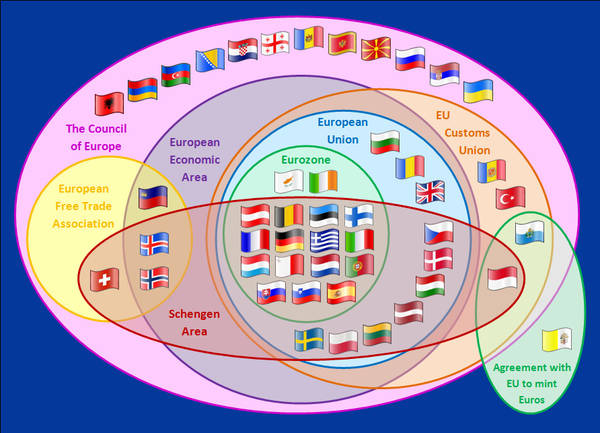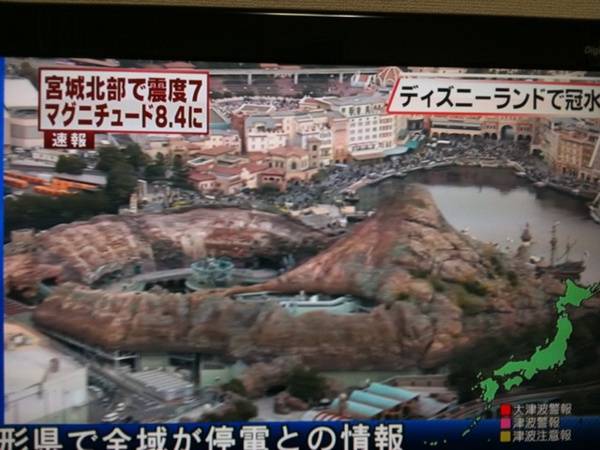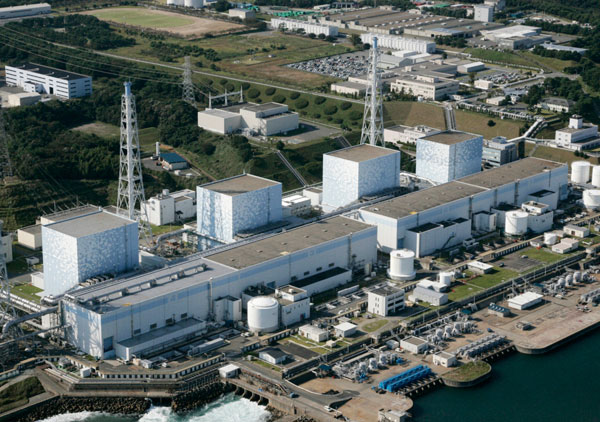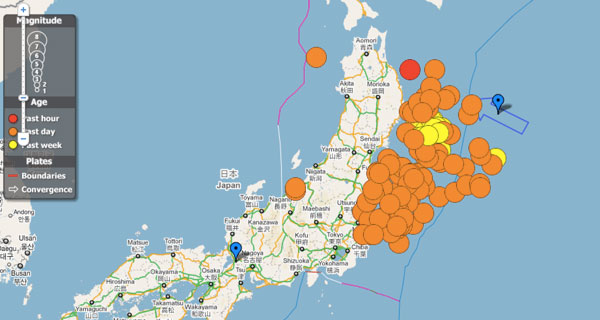The Latest from Boing Boing |  |
- Venn diagram illustrates all the different European unions, councils, zones and suchlike
- Tokyo Disneyland and the quake
- Japan: Radiation leak confirmed, meltdown fears, evacuation near nuclear plant widens (UPDATED)
- Happy 30th Birthday, ZX81!
- Club Martian
- Mapping live seismic data from Japan, as aftershocks continue
- Japanese earthquake tsunami wave hits Emeryville, CA
- Aftershock: A New Yorker on the dark side of Japan (eyewitness account of quake, from Tokyo)
- How to make a doortop stash
- Register for NASA's open source science summit
- Oregon takes a stand against faith healing
- Acoustic psychedelia from Sun City Girls' Richard and Alan
- Japan: radiation leak fears at nuclear power facilities after quake, tsunami, and strong aftershocks
- Inception remade as a 60-second Victorian woodcut animation
- How to text $10 to the Red Cross for Japan disaster relief
- State Dept. rep: "What is happening to Manning is ridiculous, counterproductive and stupid"
- Japan: video of tsunami flowing into city
- Japan: Pacific tsunami wave height model (image)
- Japan Quake: Tsunami mud wave overtakes town in northern Japan
- Japan Quake: skyscrapers swaying in Tokyo (video)
- How earthquakes work, and how science makes us safer
- Time's appraisal of the first WorldCon
- Fun with Figures -- cool geometry book for kids from 1947
- History of the Disney Haunted Mansion's stretching portraits
- Japan
- Breaking news from Japan: Maru the internet-famous cat is safe and sound.
- Japan: text, not voice, serves as communication lifeline in quake aftermath
- Japan: smart architecture and urban design saved the lives of millions
- Japan Quake: live video online from Tokyo Broadcasting System
- Japan: pressure rising inside nuclear reactor, radiation leak fears increase
| Venn diagram illustrates all the different European unions, councils, zones and suchlike Posted: 11 Mar 2011 10:55 PM PST  This handy Venn diagram illustrates the relationship between the Council of Europe, the European Union, Shengen, the Eurozone, the European Economic Area, and the European Trade Association. I had to memorise all this stuff for my "Life in the UK" test when I got my permanent residency permit, and it was actually pretty interesting, especially as compared to some of the other material. All will be aware of the 'Europe' that is a less than homogenous conglomerate of nation states, with an unwieldy Brussels bureaucracy at its centre. This European Union, which consists of 27 member states, is merely the most visible of several European unions, all committed to different versions of the same goal: European integration.505 - United Diagrams of Europe
|
| Tokyo Disneyland and the quake Posted: 11 Mar 2011 10:47 PM PST  The quake and tsunami that hit Tokyo this week stranded thousands of visitors at Tokyo Disneyland/Disney Sea (this latter being the most extraordinary built environment I've ever seen). The parks -- built on "reclaimed land" -- experienced some liquefaction. Most of the damage appears to have hit the parking lot and monorail berm. John Frost of the Disney Blog bets that the monorail will be down for some time. 69,000 guests were in the park when the quake hit, and 30,000 guests stayed behind at the park, supplied with heaters and raincoats, and then fed breakfast the next day (the trains to and from TDL being out of service). The 69,000 guests in park were evacuated to safe areas and given supplies to shelter in place over night as transportation options were affected by the quake. Twitter user Rezaikram has posted pictures of guests camped out in the common areas of the park. Among the supplies provided were "disposable heaters, plastic bags, and rain coats" according to Rezaikram.Japan Earthquake strands tourists at Tokyo Disneyland, damage reports coming in
|
| Japan: Radiation leak confirmed, meltdown fears, evacuation near nuclear plant widens (UPDATED) Posted: 11 Mar 2011 10:05 PM PST  UPDATE, 10pm PT: People are starting to throw the word "meltdown" around. Here is an NHK update reporting that venting has been suspended at the plant because of high radiation levels, and concern over pressure and possible damage to the containment vessel. Here is an AP item with a statement from a Japanese nuclear official with somewhat contradictory info. Al Jazeera: "Japanese nuclear authorities said that there was a high possibility that nuclear fuel rods at a reactor at Tokyo Electric Power's Daiichi plant may be melting or have melted, Jiji news agency reported on Saturday."
Tokyo Electric Power Company (TEPCO) reported a radiation leak at one of its two nuclear power plants in Fukushima damaged by Friday's massive earthquake, according to Japan's Kyodo News agency. More on the worsening situation around nuclear power plants affected by the quake and tsunami in this New York Times update. The prospects look increasingly frightening. TEPCO is publishing hourly updates on the situation here, in English. |
| Posted: 11 Mar 2011 07:24 PM PST |
| Posted: 11 Mar 2011 06:03 PM PST David Israel submits this cute low-fi flashtoon featuring "dozens of villains from all your favorite movies, books, comics, cartoons and games. We especially dug what they did with the Eye of Sauron. See how many you can recognize." |
| Mapping live seismic data from Japan, as aftershocks continue Posted: 11 Mar 2011 02:58 PM PST |
| Japanese earthquake tsunami wave hits Emeryville, CA Posted: 11 Mar 2011 02:20 PM PST [Video Link] Mark Demma says: "We saw this wave come ashore in Emeryville [near Oakland, CA] today. Remember it had to go through the Golden Gate first so they must have had a larger wave on the unprotected beach." (Via Telstar Logistics) |
| Aftershock: A New Yorker on the dark side of Japan (eyewitness account of quake, from Tokyo) Posted: 11 Mar 2011 02:09 PM PST  [Photo: Citizens of Tokyo evacuate the city on train tracks, after a catastrophic earthquake and tsunami struck Japan on March 11, 2011. REUTERS] The only thing more disconcerting than the typical calm Japanese people so often exhibit in the face of all manner of outlandish occurrences is actually seeing the normally buttoned-up, retrained populace lose their cool en masse. That is truly scary. And that is what I saw happen Friday afternoon, when Japan experienced what some seismologists are calling the strongest earthquake to hit Japan in a thousand years.How strong was the earthquake? I would like to now point out that even as I'm writing this at 1 a.m. Tokyo time (the major quake hit at 2:46 p.m.) we are still experiencing very strong aftershocks about once an hour. So excuse me if my observations are still tinged by frantic concern that the ceiling may still come falling down around my head. It began as a light tremor, something that one becomes oddly accustomed to when living in Japan. But then the deceptively gentle tremor kept going... and going... and going. Until the bemused giggles of my Japanese office mates gradually turned into full on screams of fear as everyone tried to duck under the nearest desk. But what really brought the thought that this might be my last Friday was the fact that the quake didn't obey the rules of good luck and suddenly stop once we all ducked under the desks. No. The quake lasted a very, very long time. Not unlike an animal's howl, the quake went from a deep rumble and gradually built up to a thunderous and sustained wave of rhythmic, humming, physical chaos. It lasted about five minutes by my guess. And if you've ever experienced an earthquake, you know that five minutes is an eternity compared to the run-of-the-mill quake. It was scary.
What I find most odd is that I'm not hearing the major cable news channels mention the fact that we experienced a similar (albeit far weaker), very long precursor earthquake earlier in the week. Clearly, that was the warning shot leading to the hit we sustained today.
As my friends and I made our way to Omotesando, the high-end shopping district in the center of Tokyo not far from where I live, the impact of the quake was apparent. For me this was the most spooky kind of déjà vu. When lived in Greenwich Village, on 9/11 I watched as thousands of office workers trudged home on foot away from Ground Zero, clothes dirty with soot and smoke they'd have to carry with them for miles as the subway was shut down. Today I watched with a strange recognition as thousands of well-heeled salarymen and perfectly coiffed office ladies made their way though the streets of Tokyo, some looking at five-hour walks ahead of them.
For some reason, that's when my old school journalist instincts kicked in and I started asking questions in horrible, yet quite serviceable Japanese. I explored the underground train stations and queried the obaasans (grandmothers) who seemed determined to wait for a train that had no promise of arriving any time soon, and I gently interrogated the station master, whose patience reminded me of why Japan is famous for its service culture.
Back topside, I poked my head into any shop that seemed to have recovered from the quake, at least on the surface. While most everyone was polite, and sometimes even informative, in contrast to the tough "we'll get through this, screw disaster!" flippancy I grew up around in New York, these people were very clearly scared, and with good reason.
Hearing the tale of The Big One is something of a rite of passage for anyone moving to Japan. The story goes (with random variations) that some scientists somewhere of some great authority have predicted that Tokyo is overdue to experience a cataclysmic earthquake that will make the Kobe earthquake of 1995 look like a game of seismic hopscotch compared to the impending doom of a major smack from Mother Nature that will rival the carnage and disintegrating buildings seen in the finale of the anime film "Akira". So while the bespoke suits and $500 hairdos ever-present in Tokyo are indeed an integral part of Japan's frosty demeanor, just below the surface, most residents silently dread the long promised day when the Big One will come and end all the fun. It's in that mental context that many scurried the streets today very seriously prepared to believe that this might be the end.
This is something of a personal ritual. In New York, whenever disaster strikes, I don't sit by the glow of cable news, I get out on the streets and look for the pulse of the event. Preferably at night, preferably on a bike.
The homeward bound crowds filling the streets seemed to peak at 4 p.m. Yet by 11 p.m. the streets were still jam packed with office workers walking home, only now framed by bumper-to-bumper traffic that moved far slower than anyone on foot. Here and there you could see a mother holding the hand of a child wearing what I can only describe as a platinum colored hood-hat that was so cute, yet simultaneously utilitarian I can only assume this is a widely used safety hat given out to children in lieu of a full on helmet to guard against falling debris. A trip to five different convenience stores to replenish my battery supply revealed only clean and completely empty shelves, dutifully manned by store workers who, despite the fact that they had nothing to sell, continued to energetically issue that familiar "irreshaimase!" (welcome) refrain. In the face of the empty shelves that hinted at social panic if left to continue another day, the Japanese sense of duty was a reassuring touchstone.
In what may come to be known historically as the Sendai Earthquake, we now learn that it was the fifth largest on the entire planet since 1900, and the largest ever in the history of earthquake-prone Japan.
Yes, this was historic, but it was also somehow personally cathartic. Today I watched one of the most crowded cities on Earth--not New York--comport itself with grace and aplomb in the face of swaying skyscrapers and a severe interruption (and in some cases, ending) to life as we know it. As a native New Yorker who experienced my city's massive blackouts and riots, and finally the end of the World Trade Center, I recognize this business of being cosmopolitan, fragile, tough and empathic all at once.
What I surprised me today is that within a culture I've spent so much time studying, and highlighting the differences of, I now understand--no, intuit that these people born on the opposite side of the planet are nothing less than exactly as courageous, terrified, and optimistically unsure as everyone I grew up with in the U.S. The Western sci-fi novels are wrong. Japan is not Mars. It's more like a space station in which our distant cousins simply have different ways. Ultimately, days like these give rise to a kind of pan-cultural adhesive that serves to bind us together no matter how different we want to think we are.
And despite the pain and the loss, that's what I think these moments in history are really for. We should not waste such opportunities. I still have butterflies in my stomach, but this space station doesn't feel as strange as it used to, and I like that.
|
| Posted: 11 Mar 2011 02:01 PM PST  Sean Michael Ragan of Make: Online shows how to make this cool "doortop stash" out of an aluminum cigar tube. I'm going to make one and use it to hide my Tweezerman Slant Tweezers (the best tool I know of to remove slivers) so that my wife and kids won't swipe them. Make: Projects - Doortop Stash (See more how-to projects from MAKE.) |
| Register for NASA's open source science summit Posted: 11 Mar 2011 01:31 PM PST Want to participate in NASA's upcoming summit on open source space science? Fittingly, given the topic, anyone can virtually join in on the conference, via live streaming, electronic discussion, and collaborative note taking. Registration is free. |
| Oregon takes a stand against faith healing Posted: 11 Mar 2011 01:26 PM PST In Oregon, faith healing has been a legitimate legal protection against certain kinds of homicide charges. Yesterday, the Oregon state House voted unanimously in favor of a bill that would remove that special protection, and stipulate mandatory sentencing for parents whose children died because the parents chose to give those children faith healing rather than medical treatment. Basically, you can make the choice yourself as an adult, but you can't choose to deny life-saving treatment to your kids. The bill's sponsors say that, in the past two years alone, two Oregon children have died, and another was severely disfigured, when those children's parents denied them medical care. |
| Acoustic psychedelia from Sun City Girls' Richard and Alan Posted: 11 Mar 2011 12:47 PM PST Dig this freak-out: Sun City Girls' Richard and Alan Bishop performing an acoustic rendition of "Space Prophet Dogon/Multiple Hallucinations" in Iowa City, 2008. Sun City Girls formed in 1979 and released a slew of eclectic, amazing, and bizarre small edition albums and cassettes until drummer Charles Gocher died in 2007. According to the Village Voice's Ted Hendrickson, Sun City Girls "never made any sense, conventionally speaking, and that's what makes them fun." (Thanks to Three Day Stubble's Mr. Hungry, who introduced me to the Sun City magic way back when!) |
| Japan: radiation leak fears at nuclear power facilities after quake, tsunami, and strong aftershocks Posted: 11 Mar 2011 02:25 PM PST  (Click for large photo: Fukushima nuclear plant in northeastern Japan, in a 2008 file photo - Reuters) Widespread concerns in Japan over a possible radiation leak at one of the country's largest nuclear facilities, after the devastating quake and tsunami. The government is warning Japanese citizens of risks, but says the situation is not yet critical. Speaking at the White House today, Secretary of State Hillary Clinton said U.S. Air Force planes are currently delivering "some really important coolant" to the Fukushima Daiichi plant, which is the focus of safety concerns. Thousands of residents near this facility are reported to have been evacuated as a precautionary measure. The Union of Concerned Scientists has a helpful analysis of the evolving situation here, with much detail on what has failed, and what is working, and what's being done to maintain safety. "Concern about a serious accident is high enough that while TEPCO is trying to restore cooling the government has evacuated a 3-km (2-mile) radius area around the reactor." Related coverage:
|
| Inception remade as a 60-second Victorian woodcut animation Posted: 11 Mar 2011 05:09 AM PST This Gilliamesque 60-second adaptation of Inception uses delightful Victorian woodcuts to tell the story. It was an entry in a Jameson's whisky competition by Wolfgang Matzl. Inception - Done in 60 seconds (via Super Punch) |
| How to text $10 to the Red Cross for Japan disaster relief Posted: 11 Mar 2011 11:51 AM PST  From George Takei's Twitter feed: "Today we are all Japanese. Give $10 to help. Text REDCROSS to 90999, or click here." From George Takei's Twitter feed: "Today we are all Japanese. Give $10 to help. Text REDCROSS to 90999, or click here." |
| State Dept. rep: "What is happening to Manning is ridiculous, counterproductive and stupid" Posted: 11 Mar 2011 11:40 AM PST "I spent 26 years in the air force. What is happening to Manning is ridiculous, counterproductive and stupid, and I don't know why the DoD is doing it. Nevertheless, Manning is in the right place." — P.J. Crowley, US State Department. |
| Japan: video of tsunami flowing into city Posted: 11 Mar 2011 08:49 PM PST [Video Link] from NHK (via Good). |
| Japan: Pacific tsunami wave height model (image) Posted: 11 Mar 2011 11:28 AM PST  This model comes from the Center for Tsunami Research at the NOAA Pacific Marine Environmental Laboratory, and displays the anticipated wave heights of the tsunami as it travels across the Pacific, after the 8.9 earthquake that struck northern Japan on March 11, 2011. The largest wave heights are expected near the earthquake epicenter, off Japan. The wave will decrease in height as it travels across the deep Pacific but grow taller as it nears coastal areas. In general, as the energy of the wave decreases with distance, the near shore heights will also decrease (e.g., coastal Hawaii will not expect heights of that encountered in coastal Japan).The second image shows the depth of the Pacific Ocean floor. Notice the similarity between areas of low wave height and deeper areas of the ocean.Animated view here, and High-resolution here. |
| Japan Quake: Tsunami mud wave overtakes town in northern Japan Posted: 11 Mar 2011 11:22 AM PST [Video Link] (Tokyo Broadcast News) |
| Japan Quake: skyscrapers swaying in Tokyo (video) Posted: 11 Mar 2011 11:21 AM PST High-rise buildings swaying during the 8.9 magnitude quake at Shinjuku, Tokyo, Japan on March 11, 2011. [video link] |
| How earthquakes work, and how science makes us safer Posted: 11 Mar 2011 04:18 PM PST 
(Reuters) The very powerful earthquake that hit Japan today was even more powerful than everybody first thought. US Geological Survey seismologists upgraded it to a magnitude 9.0—making it the most powerful earthquake to ever hit Japan. It's not unusual for scientists to revise their calculations on the strength of an earthquake, reports New Scientist. In fact, we're likely to see more recalculation on this quake. To find out more about the science happening behind the scenes of this disaster, I spoke this morning with geophysicist Brian Shiro, who works out of the NOAA Pacific Tsunami Warning Center in Ewa Beach, Hawaii. He gave me some good background information on the science of seismology and plate tectonics, and the changing technology that's making people safer in the face of powerful natural forces. Maggie Koerth-Baker: My first thought, when I heard about this earthquake, was to wonder whether it had any connection to the recent earthquake in Christchurch, New Zealand. They're both part of the Pacific Rim, could what happens on one fault line affect what happens on another? Brian Shiro: It's doubtful that there's a connection to the New Zealand earthquake, but the question isn't unreasonable. There's actually a lot that seismologists have been learning about the ways that earthquakes could possibly affect one another. If you'd asked this five years ago, they'd have said, "No way." But now, particularly after studying the Sumatra earthquake and tsunami [from 2004], there's been a lot of people looking into that question. The idea of one earthquake triggering another seems to have some legs to it. It's not a crazy idea. But the jury is still out on how often it happens. MKB: How is the Pacific Rim set up? In the maps from grade school, it looks like one, continuous gap that circles the Pacific Ocean, but I'm assuming there's more to it than that. BS: It's a bunch of distinct faults that, taken as a whole, create this so-called Ring of Fire where most earthquakes and volcanoes and other seismic activity originates. I like to think of the Earth like hard boiled egg. If you crack it a little bit, that's like the plates. The plate boundaries are riding on mushy mantle. People also use the baseball analogy, which is maybe even better because of the stitching. You can see the seam on a baseball where it's connected all the way around, but you can also see the stitching. The Pacific Rim is like that. Even though the fault systems are distinct, it forms a continuous band. It's a series of subduction zones that mark areas in the Pacific Ocean where the Pacific plate is sliding underneath another one. MKB: Why are there so many more earthquakes and volcanoes in this region. Is there something that makes the seismic activity in the Pacific Rim different? BS: It's a matter of numbers really. The Pacific Rim covers a huge portion of the Earth. Really, there's just that much more opportunity for things to happen. Look at the various seas and oceans. The Mediterranean, for instance, has one subduction zone. The Atlantic has none. The Indian Ocean has two. The Pacific has on the order of 10. MKB: What is the magnitude rating of an earthquake actually measuring? BS: Seismologists stopped using Richter Scale 20-30 years ago. That was based on ground displacement. The public still uses the name because it is so embedded in consciousness. Today, we still use a logarithmic scale like the Richter Scale, but now it's based on the amount of energy that the earthquake released. Bigger magnitude means more energy released. And that's really related to the type of rupture in the fault. MKB: There seems to have been a lot of confusion this morning about how big the tsunami waves would be by the time they hit places like Hawaii and the American West Coast. What factors make that difficult to predict? I think that, to a lot of laypeople, it seems like it must be a fairly simple distance/force physics problem. What complicates it? BS: You have to separate this out into two questions: Time, and how big it will be. Those are two very different things. Estimating when a tsunami wave will reach a place is a simple thing to do from fundamental physics. You can do it with a pen and paper, and a calculator. The key thing is that you have to know the depth of the water, which we do pretty well throughout the ocean. Then you can predict time with great deal of accuracy. We've been doing that for several decades. But knowing the size of the wave—or even if the wave will still exist after traveling a certain distance—that's another thing. There are lots of nonlinear effects. It's not trivial. This is serious fluid dynamics. Until the last 5 years, maybe, it wasn't possible to make those predictions in reasonable amount of time. Today, we have the computing power to do it in a matter of seconds. We're advancing because of computer speed. But there are still conflicting estimations, and those have to do with different computer models asking the same question. There's a lot of variation between models on methodology and assumptions—for example fault orientation and magnitude go into it. It all boils down to conservation of energy, in the end. That's what the numbers are crunching. And that gets particularly difficult when you reach the coast. Out in the open ocean this isn't a big deal. But when you get down to the nitty gritty of a coastline, then you have to take into account a lot of nonlinear effects like reflecting or refracting. That's where small differences in the models can lead to a big difference in the end. In this case, though, the models were right on for Hawaii, which means that they'll likely be good for California, as well. MKB: Cory Doctorow, one of our editors at BoingBoing, moved to California not long after the Loma Prieta earthquake and remembers people telling him that nobody really knew, until it happened, how well earthquake-proof building designs would work. Not sure if this is outside your area, but can you tell me a little about how researchers test those designs before nature tests them? BS: It is outside my area, but I can tell you a little about it. They do computer simulations, they also do shake tables that can shake the models and see what happens. Also, especially in last few years, they've installed instruments in structures like bridges and skyscrapers. Seismometers and accelerometers are both a lot cheaper now. There's an accelerometer in every iPhone. So now they can basically implant them in a building as you build it. That helps you really understand how the earth moves. One other thing: The shaking that a building experiences really depends on the type of ground it's sitting on. Bedrock won't shake as much as landfill or alluvial soil. That's why sometimes one neighborhood may be OK and in the next neighborhood over everything topples. An earthquake can liquefy soil but it can't liquefy solid rock. MKB: How well do these designs hold up when the time comes? From the little I've seen this morning, it's sounding like most of the deaths in Japan were tsunami related, rather than earthquake related. Is that a win for engineering? [NOTE: After further research, it's not clear at this time whether the earthquake or the tsunami has been responsible for more deaths than the other. We probably won't know the answer to that for a long time.] BS: If that's true then that's really interesting. It says a lot about the engineering. Japan has the most sophisticated earthquake and tsunami warning system anywhere. They have hundreds of seismic stations throughout Japan and they're all connected to an earthquake early warning system, like what California is currently developing. When these centers first detect a seismic wave, they can send a signal out ahead of the wave to dams, power plants, and subways—places that need to shut down to avoid damage. Before the earthquake even hits they can be shut down. [NOTE: This is actually why Japan, a country with 30% nuclear-powered electricity, is only having problems with two of its nuclear power plants today. The early warning system shut down 15 nuclear plants for safety. 11 of those are already back online, operating as normal. The two you've been hearing about today were those nearest the epicenter. —MKB] MKB: Is it possible to engineer tsunami safety the way we engineer earthquake safety? BS: There are. In fact, Japan again leads the way on this. They have these huge metal gates that can close off rivers, which are conduits for tsunamis traveling inland. The tsunami early warning system triggers the gates, the gates crash down, and it saves a lot of lives. There are a number of cabled offshore buoys and detectors—that gives people a few minutes notice. There's also a lot of proposals out there, too. I'm not aware of any serious efforts to implement this, but building huge artificial reefs could help because those are one of the natural protections against tsunamis. As are mangrove forests. Putting up those barriers is possible, but it would take a lot of money. You can read about some other aspects of the science of the Sendai Earthquake on LiveScience.com |
| Time's appraisal of the first WorldCon Posted: 11 Mar 2011 05:04 AM PST The July 10, 1939 issue of Time featured a condescending and sarcastic look at the first-ever World Science Fiction Convention, sneering at the "pseudo-scientifics" as published in Thrilling Wonder Stories and the 16-20 year old boys who were the "jitterbugs" of the field. The reporter mocks readers' ambition to "see that the things we read in science fiction become realities." The Press: Amazing! Astounding! (via IO9)
|
| Fun with Figures -- cool geometry book for kids from 1947 Posted: 11 Mar 2011 11:04 AM PST  If you have kids (or even if you don't) I recommend that you add the Vintage Kids' Books My Kid Loves blog to your RSS feed. I don't collect many things, but I have acquired a small collection of vintage kids' math and science books*, and my 7-year-old daughter and I love going through them. Why do I like them so much? Here's what I wrote in 2006 (about The Golden Book of Chemistry Experiments): The book is an example of everything great about vintage children's science books. Once you lay your eyes on it, you will come to the sad realization that our society has slipped backwards in at least three important ways: 1. The writing quality in old kids' science books was better; 2. The design and illustration was more thoughtful and skillful; 3. Children in the old days were allowed and encouraged to experiment with mildly risky but extremely rewarding activities. Today's children, on the other hand, are mollycoddled to the point of turning them into unhappy ignoramuses. I haven't seen a copy of Fun with Figures (1946) yet (I ordered it on Amazon, where used copies of this out-of-print title can be purchased for $2.85 and up), but from the examples posted to Vintage Kids' Books My Kid Loves, it looks like an excellent book to teach kids about geometry in the real world. Chapters include: Straight Lines, Lines That Never Meet, Angles, Reflection Angles, Lines That Cross Squarely, Triangles, Equal-sided Triangles, Shadows Measure Height, Measuring Distances, Circles, More About Circles, Round Figures, Ovals, How to Draw an Ellipse, The Parabola, Spirals, The Helix, The Thread of a Screw, Quiver Pictures, One-Sided Piece of Paper, Knots, The Three Tags, Cutting and Fitting, Tangram, Nature's Geometry, Star Cut-out, and Objects With Many Faces. Note: the cover of the book shows the boy playing with a set of Platonic solids. In MAKE Vol. 11, Charles Platt wrote a good article about how to make Platonic solids. *I'm preparing a post about my favorite old kids' science books. |
| History of the Disney Haunted Mansion's stretching portraits Posted: 11 Mar 2011 04:31 AM PST  The always-brilliant and always-exhaustive Haunted Mansion blog Long Forgotten has a great article on the history of the stretching portraits from the ride's pre-show. These portraits have to be repainted periodically (rolling and unrolling all day as the gallery stretches is hard on the materials), and different artists have interpreted them differently over the years, making the Mansion's early scenes comic or menacing by turns. The first thing I always notice about [Imagineer] Marc [Davis]'s original is that this widow is not very old. She's put on a few, but she's still cooking on all burners. Secondly, there's a huge contrast between the fried-egg madness in the eyes of Marc's Tightrope Walker and the nimble intelligence of this widow. If this is madness, it's an utterly different form of madness. This is truly a classic Marc Davis sketch, in my opinion. The self-confidence is there, the cold-bloodedness, the wicked edge. She seems quite pleased with herself. She keeps her secret without a trace of guilt feelings. And check out the colors in that face! Yellow skin, grayish-green shadows, pink ears--and yet, mirabile dictu, she doesn't look sickly but very much alive and well. Unless someone had called your attention to it (like I just did), would you ever have noticed how daring and original Marc's palette is in this sketch?The Many Faces of...the Other Stretching Portraits
|
| Posted: 11 Mar 2011 09:56 AM PST |
| Breaking news from Japan: Maru the internet-famous cat is safe and sound. Posted: 11 Mar 2011 09:46 AM PST  "Maru is safe. Thank you for worrying and praying." Previous Boing Boing post about Maru. He has a Wikipedia page and a YouTube channel. |
| Japan: text, not voice, serves as communication lifeline in quake aftermath Posted: 11 Mar 2011 09:42 AM PST CNET reports on how the people of Japan are coping with overloaded (and carrier-restricted) cellphone networks, after today's catastrophic quake: they're turning to text messaging, and "social networks like Twitter, Facebook, and Mixi." The carriers are "limiting voice calls on congested networks, with NTT DoCoMo restricting up to 80 percent of voice calls, especially in Tokyo and in northeast Japan, where 30-foot tsunami waves caused extensive damage." Anecdotal tweets describe people lining up to use payphones in Japan, with some people not knowing how they work. |
| Japan: smart architecture and urban design saved the lives of millions Posted: 11 Mar 2011 09:29 AM PST In the NYT, the headline many folks on Twitter were griping would not appear today: "Japan's Strict Building Codes Saved Lives." |
| Japan Quake: live video online from Tokyo Broadcasting System Posted: 11 Mar 2011 09:25 AM PST Some of the best live online video coverage (Japanese language) of the quake can be found here: the TBS live channel on YouTube. Related: NYT roundup of clips, and Citizentube on YouTube for curated eyewitness videos. |
| Japan: pressure rising inside nuclear reactor, radiation leak fears increase Posted: 11 Mar 2011 09:26 AM PST Reuters reports: "Tokyo Electric Power Co said pressure inside the No.1 reactor at its Fukushima-Daiichi nuclear plant has been rising, with the risk of a radiation leak." After the quake hit Japan about 12 hours ago, the plant's cooling system malfunctioned. Update: NYT item with details. |
| You are subscribed to email updates from Boing Boing To stop receiving these emails, you may unsubscribe now. | Email delivery powered by Google |
| Google Inc., 20 West Kinzie, Chicago IL USA 60610 | |



 They are exceptionally articulate. Most of these magazines have letters columns, in which readers appraise stories. Sample: "Gosh! Wow! Boyoh-boy!, and so forth and so on. Yesiree, yesiree, it's the greatest in the land and the best that's on the stand, and I do mean THRILLING WONDER STORIES, and especially that great, magnificent, glorious, most thrilling June issue of the mosta and the besta of science fiction magazines. . . ."
They are exceptionally articulate. Most of these magazines have letters columns, in which readers appraise stories. Sample: "Gosh! Wow! Boyoh-boy!, and so forth and so on. Yesiree, yesiree, it's the greatest in the land and the best that's on the stand, and I do mean THRILLING WONDER STORIES, and especially that great, magnificent, glorious, most thrilling June issue of the mosta and the besta of science fiction magazines. . . ." 

No comments:
Post a Comment